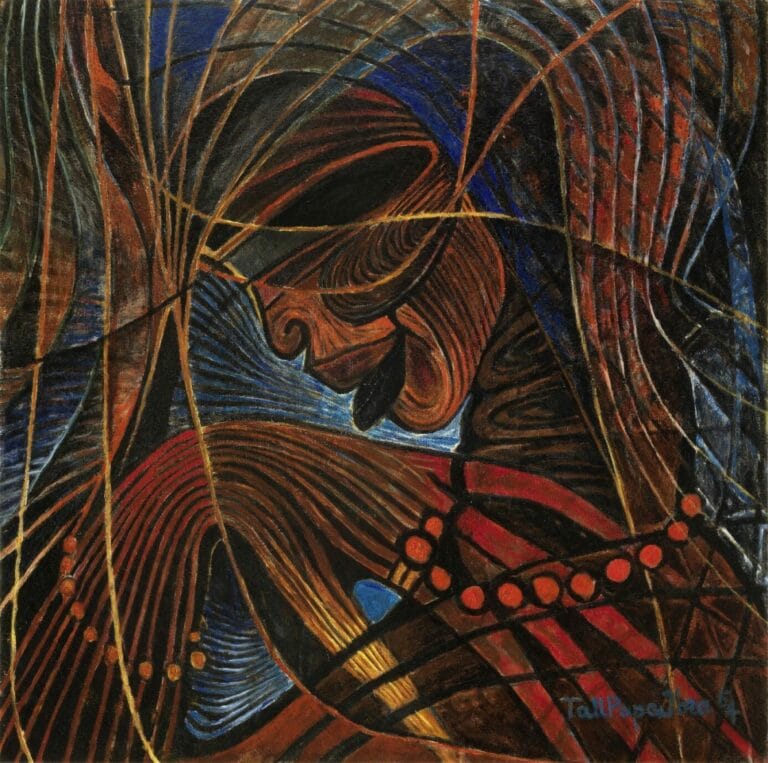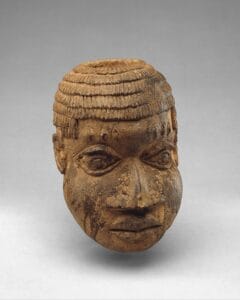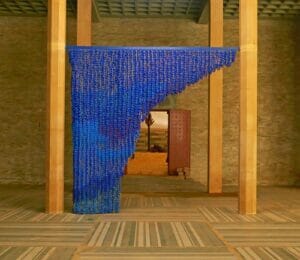The vibrant, colorful paintings by Senegalese modernists who belonged to the École de Dakar, the artistic movement that flourished in Senegal following independence from France in 1960, are increasingly setting records at auction.
Papa Ibra Tall’s striking painting, ‘Vin Noir’ (1964) of a female figure, characterized by sinuous, intersecting lines, sold for $168,825 at Bonhams in New York in May 2019, soaring past its estimate of $40,000-$60,000.
Tall was a key figure of the state-sponsored École de Dakar, which was active from 1960-1974. A painter and tapestry weaver, he aimed to create an artistic language that “seemed to belong to Africa and Senegal” and have particularities transcending the universality of art.
‘Vin Noir’ was Tall’s second painting to go under the hammer for a six-figure sum. In October 2018, ‘The Warrior’ (1964) sold for £118,750, over ten times its estimate of £8,000-£12,000, at Sotheby’s Modern and Contemporary African Art auction in London.
Part of the latter’s appeal was its provenance. The work was exhibited at the inaugural edition of the ‘Festival Mondial des Arts Nègres’ – the World Festival of Negro Arts – which took place in Dakar in 1966. Organized by Senegal’s first president, Léopold Sédar Senghor, the groundbreaking, multidisciplinary event brought together thousands of artists, musicians, dancers and writers from Africa and the diaspora. Tall gifted ‘The Warrior’ to his friend, the American jazz composer Duke Ellington, who also participated in the festival.
The École de Dakar was founded with Senghor’s encouragement. A major proponent of Négritude – the literary and political movement that advanced Black culture, Senghor believed development of the arts to be fundamental to a nation’s success.
“After independence, Senghor wanted to create ‘a new art for a new nation’,” Babacar Mbaye Diop, director of the arts and cultural institute at Cheikh Anta Diop University of Dakar, says. “Following political and economic decolonization, it was necessary to decolonize the arts. The artists trained in this school expressed Senegal’s spirit of independence through figurative representation and references to legends and African myths.”
Tall, together with Pierre André Lods, was instrumental in furthering Senghor’s vision, training an upcoming generation of artists and encouraging them to develop self-expression. While individual styles from the École de Dakar differ, what many share in common is a sense of vitality. “Formal elements such as signs and symbols are abundant in the works of artists trained by Papa Ibra Tall and Pierre André Lods, as are cubic, square and rectangular forms,” Diop says.
Another of the École de Dakar artists posthumously performing well at auction is Iba N’Diaye. Two of his paintings, ‘Portrait d’Anna’ (1962) and ‘La Signare’ (2001) depicting women set against blue and red backgrounds each fetched £40,320 at Sotheby’s in London in March and October 2021 respectively. Selling for around double their estimates, the portraits came from the collection of Raoul Lehuard, a prolific collector of tribal African arts.
Also attracting attention is Ibou Diouf, whose prominently red painting ‘Marché aux tissus’ (1964) of a bustling fabrics market went for €25,000, exceeding its €5,000-€8,000 estimate, at Sotheby’s Modern and Contemporary African Art sale in London in 2018. The price is a record for the artist whose bright, dynamic paintings blending figuration and abstraction have been regularly appearing at auctions over the last few years.
Meanwhile, works by other Senegalese artists from the École de Dakar, including Amadou Bâ, Boubacar Coulibaly, Amadou Seck, Bocar Pathé Diong and Serigne Mbaye Camara, have recently been fetching four-figure sums in sales at Artcurial and Piasa.
“The École de Dakar was the golden age of Senegalese contemporary art,”
Opines Diop, referring to how the state generously supported the arts at the time. Indeed, works by prominent artists were purchased by the state and today hang in national buildings and embassies. Senghor also gave impetus to the traveling exhibition ‘L’Art sénégalais aujourd’hui’, which kicked off at the Grand Palais before touring over the next decade to several destinations including Vienna, Helsinki and Stockholm.
The historical importance of the École de Dakar is attracting renewed institutional interest too. When the Grand Palais reopens in Paris in 2024, its inaugural exhibition will be ‘Dakar-Paris 1966’, named after the first show, ‘L’art nègre’, that was held in the galleries created by former French culture minister André Malraux and architect Pierre Vivien. As well as focusing on the history of the reception of African art objects in Paris, it will explore Senghor’s concept of Négritude and the importance of the 1966 festival.




